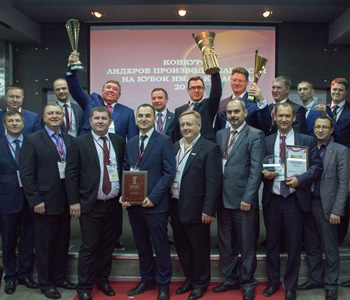The quality of customer relations is a key pillar of any business. SIBUR’s client focus gave rise to a number of initiatives set to establish and promote mutually beneficial relations with partners, with an action plan designed and key customer relationship rules drawn up. However, on top of the conventional “loyal client – stable revenue” pattern, client focus was brought into use in the context of team interaction, too.
Team play
Client focus involves the systematic and continuous work of each employee to build and develop long-term and mutually beneficial relationships with clients. A client-focused employee should understand needs of the client, meet their expectations, assist them in their work and development, maintain partnerships and deliver a positive client experience.
In 2014, at the dawn of integrating production system tools, at a meeting in the corporate centre a question arose: “Who is your customer?” The answer was unanticipated – most respondents replied it was the CEO. It revealed a grave problem of not knowing who your customer is, which gives rise to yawning gaps in interaction, including intra-company relationships.
In an efficient corporation, all units, divisions, facilities “fit” each other like gears in a Swiss watch. To eliminate any possible failures, interaction in a company should be fine-tuned: any faults impairing interaction promptly spotted, common ground sought, and partners’ objectives taken into account.
How can we summarise all these practices in building up internal relationships? The answer is easy to find: relationships with colleagues should match those with clients.
“Working in a company is always team play. And who is the most useful player, for instance, in hockey or basketball? It is not necessarily the one who scores most, passes are as important,” explains Denis Mishchenko, Director, SIBUR’s Corporate Policy function. “What is the value of a team? If you see someone stumble, you lend them a hand. It works the same way if it is you who stumbles.”
Pavel Lyakhovich, Member of the Management Board and Managing Director of SIBUR, is convinced that there is no external client focus without internal one. “When a front office person receives a request from a client, they approach a person in a production unit. If the response is along the lines of “I am really sorry, but I have my own KPIs to deliver”, the client quits. Establishing internal client focus is not a nice-to-have thing, it is a must-have requirement. If our ambition is to be client-focused outside, we cannot but build relationships inside the company and our teams.”
It appears that any dialogue and any interaction with both internal and external clients can share the same pattern based on the same client focus principles: understanding the client, meeting their expectations, assisting them in their work and development, maintaining partnership and delivering a positive client experience. These are the pillars of external client focus that SIBUR integrated into the corporate culture of team interaction.
“Client focus rules published on the intranet have been signed by 2,300 employees. No doubt, not all of them liaise with external counterparties. Rather, many of them perceive these rules as a guidance for team interaction,” says Sergey Komyshan, SIBUR’s Management Board member and Executive Director. “By the way, when we held a contest for the best client focus story, many such stories centred around the internal client focus. This is good news. Only a happy internal client makes an external client happy, and it is a recognised axiom in the science of management.”
Pragmatic tool
Working in a company is always team play. And who is the most useful player, for instance, in hockey or basketball? It is not necessarily the one who scores most, passes are as important
Internal client focus is based on simple and clear ideas. Nonetheless, changing the team interaction culture is often a tougher challenge than building relations with partners. This phenomenon can be explained by the rigid corporate framework, with each unit having its own scope of objectives and reporting to a superior for their delivery. Also, there is a set of standards and procedures governing the interaction process. This means you can deliver on an objective in a formal manner, without breaching the existing rules and procedures, or help your client address their issue and find the best solution possible. Ultimately, it is up to the person to decide which behaviour pattern to opt for.
“Another synonym for client focus is empathy. It is important to follow guidelines and regulations, but to address really complex challenges you need empathy,” says Denis Mishchenko. “There is a notorious example of Air France, which aroused heated debate in the 1990s. The company developed internal regulations for cases when a passenger is unwell. If a flight attendant followed the step-by-step instruction, but the passenger died anyway, no one could blame them, even if it was obvious that some steps in the instruction were irrelevant or some additional steps could be taken.”
“Internal client focus is each person’s urge to do their job in the best possible way by discharging their direct responsibilities and going beyond them,” says Yulia Popova, Director, SIBUR’s Corporate Policy.
But what should motivate a person to be client-focused?
“In the end, support from someone else encourages you to take on more complex assignments, and in addressing them, you discover career opportunities: if your superior has noticed and appreciated your achievements, next time you will be invited to take part in a more challenging and interesting project. You will have more trust and appreciation, which is a competitive edge. So, internal client focus is a pragmatic tool in itself,” says Denis Mishchenko.
Reciprocity
The degree of internal client focus is hard to measure in money terms. Yet, all experts agree that it serves as a starting point for external client focus. It shapes the behaviour model that is subsequently used to interact with the outside world. And, at the end of the day, it is internal client focus that has a major impact on the success of an entire company.
“I firmly believe that employee satisfaction has a direct impact on the success of a company and satisfaction of its external clients, which translates into higher financial results for the company,” says Yulia Popova.
The development of “internal client focus” as some kind of a corporate innovation is only possible when each and every employee observes its key principles. “The notion of “internal client” is very wide. One function can be an internal client of another function and act as a customer for the third function. That is why nothing is more adverse to client focus than a lack of reciprocity,” says Alexey Nikiforov, Head of Legal at SIBUR.
SIBUR develops internal and external client focuses in all fields of operation simultaneously, as they are meant to complement each other. The staff assessment system already includes the so-called “KPI B” as an addition to the job's key indicators. The new interaction efficiency KPI, which are essentially the client focus metrics, became effective for IT, the Corporate University, Procurement and HR in 2H 2016. We are also planning to introduce cross KPI for several functions that should seek to ensure top performance for each other in line with their job descriptions.
Another synonym for client focus is empathy. It is important to follow guidelines and regulations, but to address really complex challenges you need empathy
We are starting to teach our managers about internal and external client focus by integrating client focus elements into the Standard Management Practices. It is the manager who is responsible for nurturing trust in the team so that the team mates can talk to each other openly, share their ideas and take actions. One of the modules in the IMD's top and line management training programme was dedicated to client focus. On top of that, we hold special client focus sessions.
Going forward, we are planning to modify the Behavioural Competency Model by including such elements as relationships with internal and external customers and furthering the supplier–customer interaction principle. In future, potential employees are expected to take special tests to demonstrate the required competencies at the recruitment stage.
“We are at the starting point yet, but there are already excellent examples proving that employees have a natural need to be client-focused. Those include the active use of opportunities to say thank you at the corporate portal, the increasing frequency of cross-functional spot bonuses, and cross-functional training sessions. How long will it take this kind of team relationship to be integrated into the corporate culture? It is hard to say, as we are dealing with changes in the collective consciousness. I think that acting as a role model, having patience and delivering consistency are the key to achieving this goal,” says Pavel Lyakhovich.
Download PDF








